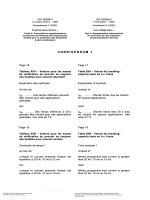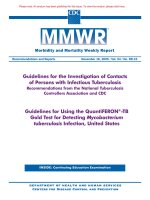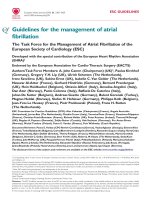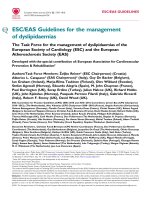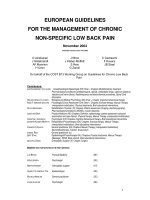OCIMF GUIDELINES FOR THE PROTECTION OF PERSONNEL FROM EXPOSURE TO BENZENE VAPOURS 1995
Bạn đang xem bản rút gọn của tài liệu. Xem và tải ngay bản đầy đủ của tài liệu tại đây (42.67 KB, 10 trang )
Page: 1
OIL COMPANIES INTERNATIONAL MARINE FORUM
GUIDELINES FOR THE PROTECTION OF PERSONNEL FROM
EXPOSURE TO BENZENE VAPOURS
AUGUST 1995
The OCIMF mission is to be recognised internationally as the foremost authority on the
safe and environmentally responsible operation of oil tankers and terminals.
The Oil Companies International Marine Forum (OCIMF) is a voluntary association of oil companies having an interest in the
shipment and terminalling of crude oil and oil products. OCIMF is organised to represent its membership before, and consult with,
the International Maritime Organization (IMO) and other government bodies on matters relating to the shipment and terminalling
of crude oil and oil products, including marine pollution and safety.
Page: 2
Table of Contents
Section
Contents
Page
1.0
2.0
3.0
4.0
5.0
5.1
Introduction
Definitions
Opinion
Scope
Recommendations
Engineering Controls
Loading
Discharging
Closed Gauging and Sampling for Custody Transfer Purposes
Tank Cleaning
Gas Freeing and Purging
Tank Entry
Management of Vent Systems
Vapour Return Systems
Accommodation Ventilation
Procedural Controls
General
Monitoring Equipment
Monitoring Strategy
Personal Protective Equipment (PPE)
Respiratory Protection
Protective Clothing
Exposure Potential in Closed Operations
Exposure Potential During Open Operations
Open Loading, Gauging and Sampling
Emergencies
1
2
2
2
2
2
2
3
3
3
3
3
4
4
4
4
4
5
5
5
5
6
6
7
7
7
Typical Respiratory Protection Factors
6
5.1.1(i)
5.1.1(ii)
5.1.2
5.1.3
5.1.4
5.1.5
5.1.6
5.1.7
5.1.8
5.2
5.2.1
5.2.2
5.2.3
5.3
5.3.1
5.3.2
5.4
5.5
5.5.1
5.5.2
Table 1
Page: 3
1.0
INTRODUCTION
Benzene is a colourless, flammable aromatic hydrocarbon which may be found as a minor component
of a number of cargoes carried by conventional tankers. Most crude oils contain less than 1% of
benzene by volume, but some petroleum products such as gasoline, may contain in the region of 3% 4% by volume. Cargoes containing up to 10% of benzene by volume may be carried on oil tankers
whereas the carriage of products containing in excess of 10% benzene is regulated by the provisions
of the relevant IMO Chemical Code.
Animal studies have implicated benzene as a carcinogen and it has been demonstrated that repeated
exposure to high concentrations of benzene vapour may lead to chronic disorders of the blood and
bone marrow. There is therefore a necessity to ensure that personnel are not exposed to hazardous
concentrations of benzene vapour during tanker operations. Prior knowledge of the benzene content
of a particular cargo will allow operators to estimate personnel exposure and effect proper counter
measures. Operators should ensure that onboard personnel are advised of the potential hazards of
benzene exposure, are aware of the procedures to be followed and are trained in the correct use of
monitoring and personal protective equipment.
Onboard training by a competent person should be performed prior to an individual's initial
assignment to a work area where benzene vapours may be present.
As a result of the potential health hazards of benzene vapour, a number of administrations have
established Permissible Exposure Limits (PEL) expressed, for example, as Time Weighted Averages
(TWA) or Short Term Exposure Limits (STEL). The PEL varies from administration to administration
but the TWA will typically range from an average exposure of between 1ppm and 10ppm over an 8
hour period. The STEL typically will range between 5ppm and 20ppm averaged over any 15 minute
period.
OCIMF supports the establishment of a consistent PEL throughout the international maritime
industry which has been shown to provide maximum protection to personnel. These PEL's are
considered the exposure limits at which controls should be implemented.
This paper contains a number of recommendations which have been developed following industry
studies of actual exposure levels experienced during tanker operations and OCIMF believes that the
guidance contained therein will assist operators in establishing procedures aimed at minimising the
exposure of personnel to benzene vapour.
Page: 4
2.0
DEFINITIONS
ï
ï
3.0
Permissible Exposure Limits (PEL) - The maximum exposure allowed by appropriate
regulatory standards, including those of flag States. PEL's are usually expressed as:
•
Time Weighted Average (TWA) - The airborne concentrations averaged over 8
hours.
•
Short Term Exposure Limit (STEL) - The airborne concentration as averaged
over any 15 minute period.
Closed Operations - Cargo transfer operations that are conducted to minimise on-deck
concentrations of vapours. Generally this will entail venting vapours through the mast riser
or high velocity vents so that vapours are dispersed clear of the working deck and
accommodation areas. In addition, closed operations require that gauging and sampling
activities be conducted without directly opening the cargo tanks to atmosphere.
OPINION
OCIMF is of the opinion that effective 'closed' operational procedures, reinforced by an appropriate
exposure monitoring programme and supplemented, where necessary, by the provision of personal
protective equipment (PPE), will serve to minimise the exposure of personnel to benzene vapour.
4.0
SCOPE
The guidance contained in this paper has been developed for application by tanker and barge
operators engaged in the carriage of crude oils and petroleum products having a benzene content of
over 0.5% by volume but less than 10%. However, it should be noted that significant benzene
vapour concentrations may occasionally occur when loading cargoes with a benzene content of less
than 0.5% at terminals subjected to unusual environmental conditions, such as still air combined with
temperature inversion or high ambient temperatures.
5.0
RECOMMENDATIONS
Significant concentrations of benzene vapour may be present around the working deck of tankers
during routine cargo operations. However, industry exposure monitoring programmes have clearly
demonstrated that closed operational procedures are effective in reducing these concentrations.
The risk of personnel exposure will be greatest during cargo related activities such as loading,
gauging, sampling, tank cleaning and manual removal of solid residue from tank bottoms, tank entry,
hose connection and hose disconnection. It is therefore important that systems and procedures are
developed with the aim of minimising exposure to vapours during these routine activities by
introducing a combination of engineering and procedural controls, as described below.
5.1
Engineering Controls
5.1.1
Closed Operations
i) Loading
During closed loading operation, ullages should be monitored by a closed gauging system.
To permit continued closed operational capability in the event of failure of a closed gauging
unit, consideration should be given to providing an appropriate back-up gauging system,
such as portable units through vapour locks.
Page: 5
ii) Discharging
During the discharge operation, tanks should be kept closed and inert gas or air admitted to
the tanks via the approved system. When not discharging from a tank, apertures should be
securely closed. When discharging with open sighting or ullage ports, care should be taken
to ensure that vapours are not inadvertently discharged during any gravity transfer of cargo
between tanks.
5.1.2
Closed Gauging and Sampling for Custody Transfer Purposes
Closed gauging or sampling for custody transfer purposes will normally be carried out using
the fixed gauging system or by using portable equipment passed through a vapour lock.
Such equipment will enable ullages, temperatures, water cuts and interface measurements to
be obtained with the release of minimal amounts of cargo vapour. In order for measurements
from the equipment to be acceptable to cargo surveyors it is important that the vapour lock
standpoints are calibrated and that corrections for trim and list are detailed in an approved
copy of the calibration tables. Likewise, instruments such as electronic thermometers should
be routinely calibrated according to manufacturers' recommendations.
Where it is not possible to gauge and sample under closed conditions, reference should be
made to the guidance given in Section 5.5.1.
5.1.3
Tank Cleaning
During tank cleaning operations following the carriage of cargoes containing benzene,
personnel may be exposed to high concentrations of benzene vapours. On inerted product
carriers, consideration should be given to the benefits associated with installing fixed tank
cleaning machines, as the use of these machines will greatly reduce the concentration of
vapours around the working deck.
When installing fixed machines, or connecting portable hoses to them, the equipment should
be confirmed to be effectively electrically bonded to the ship's structure. When installing
fixed tank cleaning machines on non-inerted ships, operators should be aware that the
presence of an earthed probe within the tank may pose a potential hazard. Static electricity
precautions as outlined in the International Safety Guide for Oil Tankers and Terminals
(ISGOTT) should be followed at all times.
5.1.4
Gas Freeing and Purging
When ventilating and purging cargo tanks, procedures should be adopted to minimise the
exposure of personnel to benzene vapours at deck level. These may include the use of purge
pipes, portable standpipes or mast risers. All non essential personnel should be kept well
clear of the area where these operations are being conducted and work within these areas
should be governed by the recommendations in Section 5.3.
5.1.5
Tank Entry
A low L.E.L. reading with an explosimeter is not sufficient evidence to indicate that the
benzene concentration in a cleaned tank or the deck area around it is within acceptable
limits. Prior to tank entry, tests with suitable equipment as outlined in 5.2.2 should be
performed to determine the benzene concentration and PPE that may be required. (See
5.2.3). It is important that tank atmospheres are continually or regularly re-checked for
benzene concentrations.
Page: 6
5.1.6
Management of Vent Systems
To gain optimum benefit from closed loading procedures, the equipment necessary for its
efficient implementation should be properly maintained and correctly set.
Mast risers are usually simple and effective units. However, the efficient dispersion of
vapours away from the vicinity of the working deck may be impaired during slow loading or
when loading under still air conditions.
High velocity vents, are generally considered to be more effective than mast risers and,
where fitted should be used in automatic mode to ensure that vapours are efficiently
dispersed to atmosphere. When loading, the vents should not be used with their weights or
nozzles held in the open position.
During loaded passages, when excess pressure on the cargo tanks is detected, a controlled
release of vapours to atmosphere is preferable to automatic release of vapours. Non-essential
personnel should remain well clear of the area where venting is being performed. Work
within these areas should be governed by the recommendations in Section 5.3.
5.1.7
Vapour Return Systems
A vapour return system enables the vapours displaced from cargo tanks during loading to be
transferred ashore for processing. These systems, for which standards have been developed
by the International Maritime Organization (IMO), are very effective in reducing
concentrations of benzene vapour on deck.
5.1.8
Accommodation Ventilation
The ventilation of accommodation spaces should be controlled with the aim of minimising
the introduction of cargo vapours through inlet fans and trunking. Where necessary, the air
conditioning system should be used in the recirculation mode.
Accommodation and engine room spaces should be included in any vapour exposure
assessment programme, particularly during unusual environmental conditions, such as still
air combined with temperature inversion or high ambient temperatures.
5.2
Procedural Controls
5.2.1
General
Procedures should include details of an exposure monitoring programme aimed at verifying
the on deck concentrations of benzene vapours for all operations being performed. Areas
where the benzene vapour concentrations exceed, or are expected to exceed the PEL, should
be determined by exposure monitoring and all non essential personnel kept well clear of the
area. Work within these areas should be governed by the recommendations in Section 5.3.
Procedures should also be developed to provide guidance on action to be taken in the event
of an accident or emergency involving personnel being possibly exposed to benzene vapours
in excess of the PEL. Such guidance should include the need for suitable medical
examination including, where possible, biological monitoring to assess actual levels of
exposure experienced. The results of such medical assessment should be kept on record
under the normal confidential procedures practised by the medical profession.
Page: 7
5.2.2
Monitoring Equipment
Benzene vapours can be monitored by:
i.
Colorimetric Detector Tubes - benzene specific tubes may be used to obtain a spot
indication of benzene vapour concentrations - a 'grab' sample. As readings obtained
from these tubes are not time weighted they cannot be used to determine Time
Weighted Averages or PEL's. In addition, it should be noted that tubes and pumps from
differing manufacturers are not interchangeable. The accuracy of these tubes will be
dependent on a number of factors, and manufacturers literature should always be
consulted for information referring to, for example, standard deviations, operating
conditions and potential cross sensitivities.
ii. Pumped and Diffusion Samples - These may be used for determining TWA's and
STEL's. Equipment includes pumps and sorbent tubes containing charcoal or passive
diffusion badges containing charcoal. The samples require analysis at a suitable
laboratory to obtain time weighted exposure values.
iii. Portable Gas Chromatograph - May be used to allow more accurate and continuous
in-tank atmosphere monitoring for hydrocarbon vapour and benzene concentrations
when personnel are physically working within a tank.
5.2.3
Monitoring Strategy
Monitoring is recommended should doubt exist as to the effectiveness of gas dispersion
around the vessel.
Ideally, exposure assessments should be undertaken under 'worst case' conditions, for
example, low wind speed in conjunction with high ambient and cargo temperatures.
Long duration operations, such as cargo loading or tank entry should be monitored to obtain
8-hour breathing zone samples (TWA's).
Short duration operations having high potential for exposure, such as tank gauging and
sampling should be monitored to obtain 15-minute breathing zone samples (STEL's).
Grab samples will provide an indication as to whether or not the use of personal protective
equipment (PPE) may be necessary. Grab samples should also be taken prior to responding
to a spill and as part of entry procedures prior to entry into a tank that has recently contained
a cargo having a benzene component.
Records of exposure monitoring activities should be maintained in accordance with flag
State requirements.
Due to the potential chronic effects of exposure to benzene, several administrations now
require regular suitable health checks on personnel who, by job function, may be exposed to
significant quantities of benzene vapours.
5.3
Personal Protective Equipment (PPE)
Where exposure monitoring indicates that personnel may be exposed to potentially hazardous
concentrations of benzene vapour, personal protective equipment (PPE) should be used. This may
include respirators, breathing apparatus and protective clothing.
5.3.1
Respiratory Protection
Respiratory protection should be worn by all personnel who may be exposed to benzene
concentrations exceeding the PEL. Such protection may range from simple air purifying
Page: 8
cartridge respirators with half or full face masks through to positive pressure self-contained
breathing apparatus.
Should uncertainty exist as to the actual benzene vapour concentrations, it should be
assumed that concentrations exceed the PEL until such time as monitoring indicates whether
or not a hazard actually exists.
Refer to table 1. for typical respirator protection factors for generic types of respiratory
protection equipment.
Equipment Type
Protection Factor
Half Mask Air Purifying Respirators with organic vapour
10
cartridges
Full facepiece respirator with organic vapour cartridges.
100
Full facepiece gas mask with chin style canister.
100
Full facepiece powered air purifying respirator with organic
1,000
vapour canister.
Self-Contained Breathing Apparatus with full facepiece in
10,000
pressure demand mode.
*Example - If the permitted TWA is 1 ppm and the actual vapour concentration is 25
ppm, the full facepiece respirator with organic vapour cartridge (Protection Factor 100)
will reduce the inhalation exposure to well below the required TWA.
Table 1. - Typical Respiratory Protection Factors (Source: ANSI Z88.2:1992)
N.B. Protection factors are unique for each manufacturers equipment. Selection of an
appropriate respirator should always be based on exposure monitoring, the manufacturer's
recommended protection factor and be appropriate for the work environment that is to be
encountered.
5.3.2
Protective Clothing
Although the primary risk from benzene is through inhalation of airborne vapour, it may
also be absorbed through the skin. Personnel who may come into contact with cargoes
containing benzene should wear protective clothing such as impervious overalls, aprons,
boots, gloves and goggles as appropriate.
5.4
Exposure Potential in Closed Operations
Even on vessels that are operating closed and with all engineering and procedural controls in place, a
number of operations remain that may expose personnel to potentially hazardous concentrations of
benzene vapours. These include:
•
Connecting/disconnecting - every effort should be made to ensure that cargo hoses
and loading arms are effectively drained prior to connection/disconnection and
consideration should be given to purging them with inert gas or nitrogen. It is
recommended that cargo hoses be fitted with valves adjacent to the presentation
flange in order to minimise the risk of product spill on disconnection.
•
Tank Cleaning - when portable machines are used through deck openings,
personnel could be exposed to vapours.
•
Maintenance of Pumps and Pipelines - prior to being opened up for maintenance,
pumps and pipelines should be thoroughly flushed with clean water and drained.
Where necessary, personnel engaged in any of the aforementioned operations should be provided
with, and required to use, the appropriate personal protective equipment (PPE) to protect them from
inhalation and contact hazards.
Page: 9
5.5
Exposure Potential During Open Operations
5.5.1
Open Loading, Gauging and Sampling
Where operations cannot be conducted under closed conditions, PPE should be worn by all
personnel engaged in loading, gauging, and sampling unless a monitoring programme has
indicated that they will not be exposed to potentially hazardous concentrations of benzene
vapours in excess of the PEL.
5.5.2
Emergencies
In emergencies such as deck spills and tank rescue, where the benzene concentrations are
not known or cannot be determined, personnel involved in responding to the incident should
utilise PPE that will afford the maximum protection, i.e., full protective clothing and
positive pressure self contained breathing apparatus.
_______
Page: 10
Issued by the
Oil Companies International Marine Forum
OIL COMPANIES INTERNATIONAL MARINE FORUM
27 QUEEN ANNE’S GATE
LONDON SW1H 9BU
ENGLAND
TELEPHONE: 0171-654 1200
FAX: 0171-654 1205
TELEX: 24942
CABLES: OCIMFOR LONDON SW1
REGISTERED OFFICE:
CLARENDON HOUSE
CHURCH STREET
HAMILTON 5-33
BERMUDA
Notice of Terms of use:
While the advice given in this document ("document") has been developed using the best information currently available, it is
intended purely as guidance to be used at the user's own risk. No responsibility is accepted by the Oil Companies International Marine
Forum (OCIMF), the membership of OCIMF, or by any person, firm, corporation or organisation [who or which has been in any way
concerned with the furnishing of information or data, the compilation or any translation, publishing, supply or sale of the document]
for the accuracy of any information or advice given in the document or any omission from the document or for any consequence
whatsoever resulting directly or indirectly from compliance with or adoption of guidance contained in the document even if caused by
a failure to exercise reasonable care.


